-
Nature of the Universe
The Big Bang!
1. How can we tell a star's or galaxy's speed or direction?
Shifting Spectral Lines!
It is not the distance between the lines or their brightness; instead, it is how all the lines are "shifted" towards the red or blue end of the spectrum.
This is called the Doppler Effect!
Watch the following.This is an apparent shift due to relative motions!
2. What happens to the pitch of a car's horn as it passes you?
3. Which frequency of light has a higher and lower frequency?
4. How is this effect in starlight evidence for the Big Bang?
Let's draw some spectral shifts!Draw the following in your journal.

5. What would be an easy way to remember the difference between the Red and Blue shifts?
Blueshift = headlights = driving towards you.
 Redshift tail lights = driving away from you.
Redshift tail lights = driving away from you.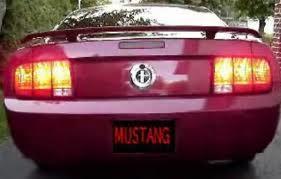
Important NOTE
Red and Blue spectral shifts have NOTHING to do with the temperature of a star.
The actual star's color tells us how hot it is, while the shifting of the spectra tells us how fast it moves towards or away from us.
6. What do we know about a Red Giant star with a blue Doppler shift?
Red Giant = Big, Cool Star that is running out of fuel
Blue Shift = the star is moving towards us.
Using a star's spectral shift, we can determine the direction and speed at which stars move, how stars revolve around galaxies, how galaxies move relative to each other, and, ultimately, what is happening to the size of the Universe!
When we look out at the universe, we notice something funny about the movement of galaxies.
7. Edwin Hubble Discovered:
All distant galaxies in the visible universe are shifted RED!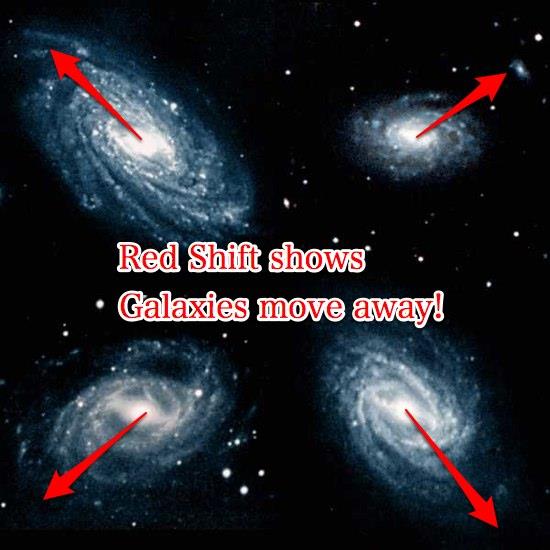
8. What does this observational fact tell us about what is happening in the universe? The Universe is expanding.9. What other things could we extrapolate from this data?
We can figure out when everything was all together.
This idea became known as the Big Bang.10. What is one light year?11. How far away is Polaris?12. Why are galaxies red-shifted?13. How come galaxies that are farther away are more red-shifted?
14. The Big Bang Theory
Please write this in your journal.1. Giant explosion/expansion sent everything expanding in all directions (still happening today).
2. Gravity, clumped matter together, forming galaxies, stars, planets, etc...
3. Universe is still expanding.
4. The rate (speed) of expansion is increasing.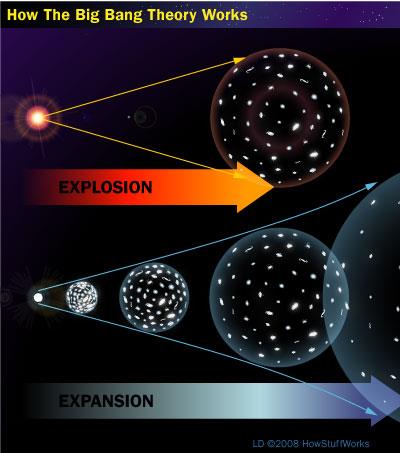
This is supported by all the evidence we find in every direction that we look in outer space.
The Evidence!
15. Can we see the first light from the Big Bang?
Yes! It is called the Cosmic Microwave Background Radiation!
16. What is the Cosmic Microwave Background Radiation?
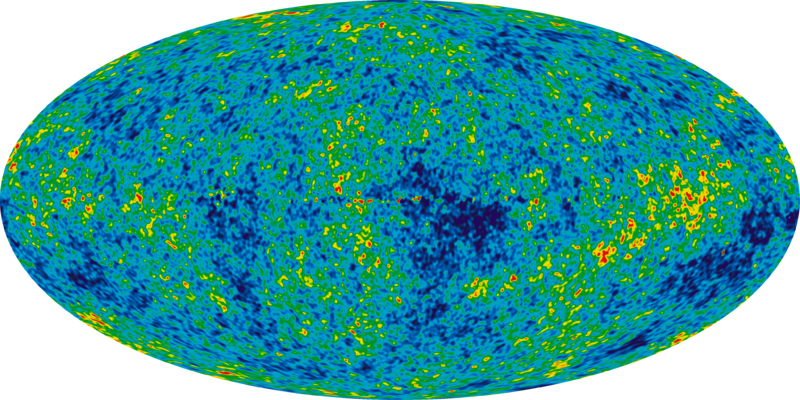
Radiation-energy left from the big bang coming from everywhere in the universe. A NASA satellite has taken a picture of the Big Bang's ancient afterglow. Scientists have analyzed the data and learned that the universe is 13.8 Billion years old and that the first stars appeared only 200 million years after the Big Bang.
Cosmic Microwave Background Radiation (CMB or CMBR) is the name given to the very dim and distant after-glow of the Big Bang coming from every point in the universe. Arno Penzias and Robert Wilson shared the 1978 Nobel Prize for Physics for their accidental discovery of the radiation made fourteen years earlier. It provides perhaps the most conclusive evidence for the Big Bang model of the universe yet.
Due to the speed of light being finite, the further out we look into space the further back we look in time. The CMB is the furthest back we will ever be able to see; it was emitted only a few hundred thousand years after the Big Bang (a blink of an eye in astronomical terms) when the universe was unimaginably hot and dense. Now it has cooled to 2.73K (-270 C).
The radiation is uniform to one part in ten-thousand in every direction. It is this uniformity that suggests so strongly that it comes from the big bang: no local source could produce it. It is only since the development of the sensitive equipment in the Cosmic Microwave Background Explorer (COBE) and it successor, the Wilkinson Microwave Anisotropy Probe, that tiny fluctuations have been discovered and mapped.
17. Why did they scrub the telescope to get rid of pigeon poop?18. Where did the CMB come from, and how did it get to be everywhere?19. What happens to the temperature of gas when it expands?20. What happened during the epoch of recombination?21. What is "Dark Energy" doing?If you could see this light every night with your eyes, the Big Bang would probably not be very controversial.22. Does the Big Bang explain the creation of the Universe?
No. The Big Bang Theory is not about the origin of the universe, it does however explain very well what happened to the universe since its beginning.
Practice Questions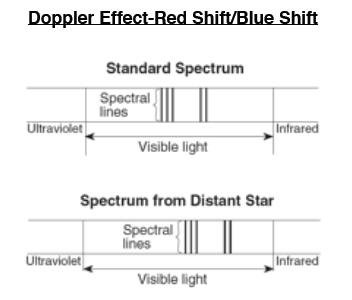
1. The Doppler effect supports the idea that the universe is Expanding
2. Redshifts support the idea that objects are moving away from one another
3. Blue shifts support the idea that objects are moving Toward one another
4. How long ago did the Big Bang occur? 13.8 Billion years ago
5. What side of the spectrum is infrared radiation on? Longer Wavelength
6. What side of the spectrum is Ultraviolet Radiation on? Shorter Wavelength
7. The Red end of the spectrum is (long or short) wavelength? Long
8. The Blue end of the spectrum is (long or short) wavelength? Short
9. What is the name of the galaxy that we live in? Milkyway
10. What type of galaxy do we live in? Spiral
11. Extremely red-shifted Galaxies are Extremely Far away from us.
12. Extremely red-shifted Galaxies are moving Very Quickly away from us.
Reflection
1. Explain how the Doppler Effect is observed in sound and light.2. Explain what the Doppler Effect tells us about the size and age of the universe.3. Why is looking out into space like looking back in time?
BonusRecite from memory the Galaxy Song
from Monty Python's "Meaning of Life"
You can sing it in class, after school, or recite it to me from memory.
You can even do it with a partner.Galaxy Song
Just remember that you're standing on a planet that's evolving
And revolving at nine hundred miles an hour,
That's orbiting at nineteen miles a second, so it's reckoned,
A sun that is the source of all our power.
The sun and you and me and all the stars that we can see
Are moving at a million miles a day
In an outer spiral arm, at forty thousand miles an hour,
Of the galaxy we call the 'Milky Way'.Our galaxy itself contains two hundred billion stars.
It's a hundred thousand light years side to side.
It bulges in the middle, sixteen thousand light years thick,
But out by us, it's just three thousand light years wide.We're thirty thousand light years from galactic central point.
We go 'round every two hundred million years,
And our galaxy is only one of millions of billions
In this amazing and expanding universe.The universe itself keeps on expanding and expanding
In all of the directions it can whiz
As fast as it can go, at the speed of light, you know,
Twelve million miles a minute, and that's the fastest speed there is.So remember, when you're feeling very small and insecure,
How amazingly unlikely is your birth,
And pray that there's intelligent life somewhere up in space,
'Cause there's bugger all down here on Earth.

